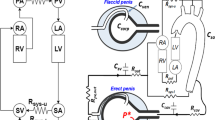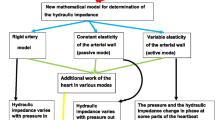Abstract
A model of a vessel exposed to external pressure was developed. Analytical derivation resulted in closed-form expressions describing pressure-flow relation in the vessel. These expressions describe a behavior of a unidirectional leaky valve. The vessel model was used to represent internal arteries and veins in the penis. Together with a compliant chamber representing the corpus cavernosum, the model demonstrates the valve action of the partially collapsed vessels during penile erection. This explains observations regarding arterial backflow during erectile contraction of the ischiocavernous muscles and demonstrates the differences in development of tumescence and rigidity.
Similar content being viewed by others
References
Aboseif, S., and T. F. Lue. Hemodynamics of penile erection.Urol. Clin. North Am. 15:1–7, 1988.
Azadzoi, K. M., J. Vlachiotis, M. Pontari, and M. B. Siroky. Hemodynamics of penile erection. III. Measurement of deep intracavernosal and subtunical blood flow and oxygen tension.J. Urol. 153:521–526, 1995.
Benoit, G., V. Delmas, C. Gillot, and A. Jardin. The anatomy of erection.Surg. Radiol. Anat. 9:263–272, 1987.
Borowitz, E. Theoretical Analysis of the Penile Erection Mechanism. Tel Aviv: Tel Aviv University, M.Sc. Thesis, October 1994.
Frohrib, D. A., I. Goldstein, T. R. Payton, H. Padma-Nathan, and R. J. Krane. Characterization of penile erectile states using external computer-based monitoring.J. Biomech. Eng. 109:110–114, 1987.
Hafez, E. S. E., and E. Spring-Mills. Male accessory sexual organs. In Human reproduction: conception and contraception (second edition) Hagerstown, MD: Harper & Row, 1980, pp. 60–86.
Knispel, H. H., and R. Andresen. Evaluation of vasculogenic impotence by monitoring of cavernous oxygen tension.J. Urol. 149:1276–1279, 1993.
Kursh, E. D., W. T. Jone, S. Thompson, D. Nelson, and F. Miraldi. A dynamic dual isotope radionuclear method of quantifying penile blood flow.J. Urol. 147:1524–1529, 1992.
Moreno, A. H., I. K. Katz, L. D. Gold, and R. Y. Reddy. Mechanics of distension of dog veins and very thin walled tubular structures.Circ. Res. 17:1069–1080, 1970.
Tejada, De S., P. Moroukian, J. Tessier, K. Je Jong, I. Goldstein, and D. Frohrib. Trabecular smooth muscle modulates capacitor function of the penis: studies on a rabbit model.Am. J. Physiol. 260:H1590-H1595, 1991.
Vardi, Y. PO2 penile brachial index: a new diagnostic test for cavernosal vascular function (abstract).J. Urol. 147: 266A, 1992.
Author information
Authors and Affiliations
Rights and permissions
About this article
Cite this article
Barnea, O. A theoretical unidirectional valve based on functional collapse of blood vessels in the penis. Ann Biomed Eng 25, 470–476 (1997). https://doi.org/10.1007/BF02684188
Issue Date:
DOI: https://doi.org/10.1007/BF02684188




